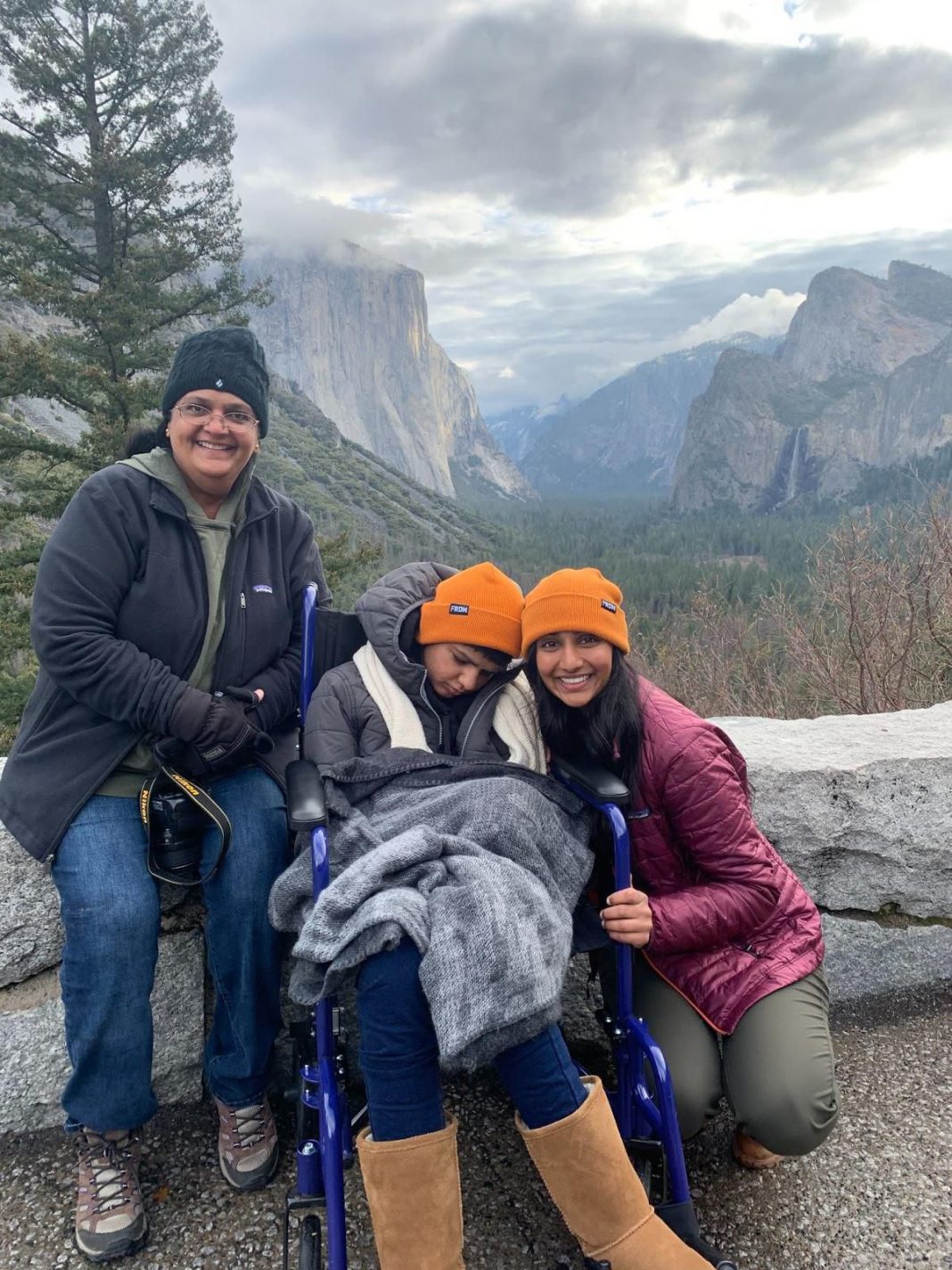
Ambika Rajyagor and her family bring her sister Devika, who is disabled, to state and national … [+]
Ambika Rajyagor
In late April, Ambika Rajyagor’s younger sister Devika underwent a risky and frightening procedure: a vagus nerve stimulator (VNS) was surgically replaced, and implanted above her heart. The goal was to stop the more than 100 seizures she experiences any given day.
The outpatient surgery was a success, and while on their way to the pharmacy afterward, Rajyagor and her family took a slight detour to Chino Hills State Park, a family favorite just a few miles away from their home in Chino Hills, California. The family sat, listened to the birds, and observed the incredible views.
It was the perfect end to a stressful day.

After Devika had surgery above her heart, the Rajyagor family took her to Chino Hills State Park to … [+]
Ambika Rajyagor
“That was the best memory of the week because we knew that we had made it through this challenging day. And then we had that moment together where we all just kind of felt like we were breathing again — and exhaling all together,” Rajyagor said.
“I think that’s the best example of why we love the outdoors so much: It’s where we can all go to feel relief at the same time.”
Rajyagor, an outdoor enthusiast, and her family have often found themselves on top of hills and mountains and in state and national parks. But, it’s not always a smooth journey to get there – and once they arrive, they frequently run into issues. The lack of accessibility can be daunting for Devika, who has intellectual disabilities, cerebral palsy, severe epilepsy, and uses a wheelchair full-time.
Her family has always strived to provide Devika “the most normal life possible” and always include her on their outdoor trips and outings. More often than not, though, they find little information on government/public websites about what state and national park trails are accessible, and what to expect once they are on the path.

Devika Rajyagor smiles after having a vagus nerve stimulator (VNS) surgically replaced, and … [+]
Ambika Rajyagor
It’s a sentiment felt by much of the disabled community, including Mike Passo, the executive director for American Trails, a trails advocacy organization that, according to their mission statement, “advances the development of diverse, high-quality trails and greenways for the benefit of people and communities.”
Passo has been on the American Trails board for 16 years, advocating for more outdoor accessibility. For Passo, the issue is personal. He broke his back in 1991 mountain biking and has since used a wheelchair. Prior, he was always an outdoorsman; after his injury, he got involved with assessing trails for accessibility and conducting training on building trails that are sustainable and accessible.
But over time, Passo says, not much has changed to improve people with disabilities’ experiences outdoors. It’s the reason he, along with other outdoor hobbyists with disabilities, spoke at a hearing of the House Natural Resources Subcommittee on Oversight and Investigations in late April.
Passo spoke about the obstacles people with disabilities face when it comes to accessibility on public lands. Specifically, he said lack of information “is the single greatest barrier to accessibility on public lands,” and there is a need for more comprehensive information available about accessibility online. Right now, on most national parks and government websites, if it’s accessible, there will sometimes be a wheelchair icon. But according to Passo, that icon is not enough.
“Disability is on a spectrum, there’s no two people experiencing disability the same. Just putting a wheelchair-accessible symbol on a campsite or trail, what does that mean?”
Right now, because of a lack of information, Passo says, people with disabilities typically have to become online sleuths, checking out blogs, and social media posts about what they might encounter, even on “accessible” trails.
In his congressional testimony, Passo encouraged websites like recreation.gov, a publicly available website with content about America’s various landmarks and parks, with information coming from 12 federal agencies, including the Bureau of Land Management and U.S. Forest Service, to expand and include detailed accessibility information.
“In the case of trails, what was the grade? What’s the maximum grade I would experience on that trail? What’s the maximum cross slope I would experience on that trail? What is the minimum width that trail gets to at any point? What’s the surface type? And how firm is it? And then what size of obstacles would I hit?” Passo said.
“It allows people to assess what they need and apply it to their experience.”
Passo also recommended adding accessibility guidelines for outdoor developed areas and trails in the Americans With Disabilities Act (ADA.) Currently, there are guidelines in the Architectural Barriers Act (ABA), which only applies to federal lands — leaving states, cities, counties, and private areas to fend for themselves.
“It’s been like 20 years, and we know that the ABA guidelines work just fine. So I think they should be moved into the ADA, to alleviate and make it consistent across the board, what is expected of new trail development in new areas, and new campgrounds, things like that,” Passo said.
Rep. Katie Porter (D-CA), the Chair of the House Natural Resources Subcommittee on Oversight, agrees there is more work to be done.
In an email statement, Rep. Porter said, “Our public lands are national treasures belonging to all Americans, and they should be accessible to all Americans. Yet, this promise is not a reality for many people with disabilities. As Chair of the House Natural Resources Subcommittee on Oversight, the first hearing I held was about how we can strengthen accessibility on our public lands because Congress needs to hear the voices of Americans with disabilities when we make policy.”
Although Passo believes Congress well received his argument, he points to a report he wrote in 1999 called “The Improving Access to Outdoor Recreation Activities on Federal Lands.” He re-read it in preparation for the hearing and realized the issues were the same then that they are today.
But, he still has hope. So does Rajyagor, although she’s taken matters into her own hands. She runs a social media platform called ‘Disabled & Outdoors’ to promote better outdoor accessibility while creating a space where people with disabilities can find accessible trail/outdoor excursion information.

Ambika and Devika Rajyagor pose in front of a large General Sherman tree at Sequoia National Park.
Ambika Rajyagor
Still, she wishes accessibility information was available on state and federal websites as a one-stop-shop.
“If it were available on the actual park websites, that would be even better. I feel like more people would be inclined to go out because not everybody wants to do a deep dive, that’s a huge task to take on,” Rajyagor said.
“But seeing that other people have testified to Congress, that is empowering. And makes it feel like, okay, people are listening, and they are paying attention and, the more awareness we bring to it, maybe we could actually see change.”




